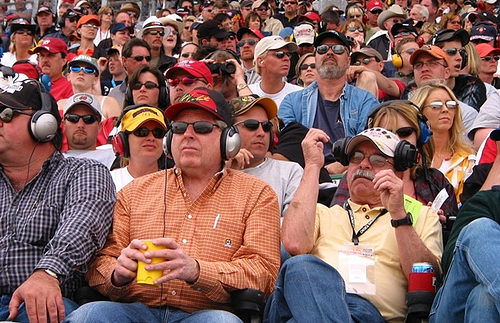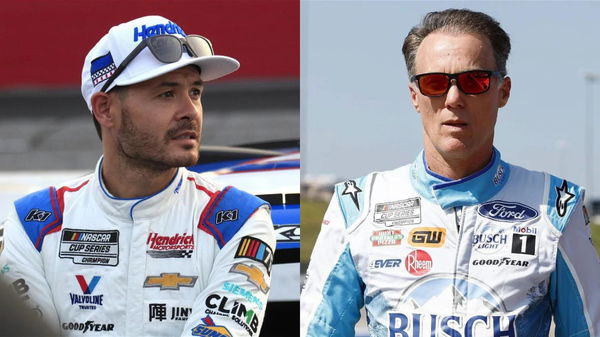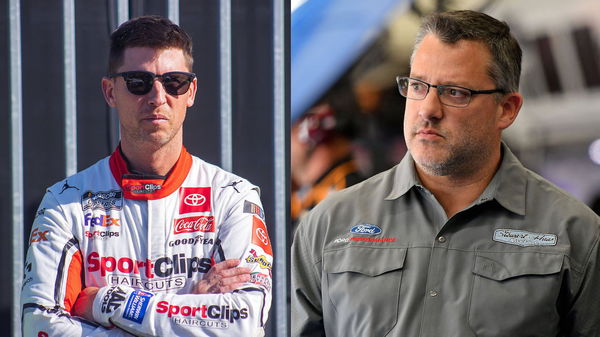Hours After Chase Elliott’s Ban, Fans Uncover the Heartbreaking “Fatal” History of the Wreck That Recently Involved Denny Hamlin

Follow Us

USA Today via Reuters
Feb 21, 2021; Daytona Beach, Florida, USA; NASCAR Cup Series driver Chase Elliot (9) is spun by NASCAR Cup Series driver Denny Hamlin (11) during the O’Reilly Auto Parts 253 at Daytona International Speedway. Mandatory Credit: Jasen Vinlove-USA TODAY Sports
Undoubtedly, NASCAR is a dangerous sport where accidents are commonplace. In the past, drivers have even lost their lives on the track. Diving a little deep into these accidents and altercations, rear hooking is a well-known occurrence that has contributed to a majority of accidents. A recent incident involving Chase Elliott and Denny Hamlin at the Charlotte Motor Speedway was one such wreck. Not only did the accident end the run for both drivers and got Eliott suspended for one race, but it also served as a stark reminder of previous “fatal” wrecks.
A recent tweet by motorsports enthusiast, Darian Gilliam, caught the attention of many. The tweet featured images of two different incidents triggered by rear hooks. The post also emphasized the danger associated with them.
The user claimed that these hooks can sometimes be fatal. One of the photos was of a fatal crash involving Blaise Alexander back in 2001. This photo served as a scary reminder for NASCAR fans, as it illustrated a period when five drivers tragically lost their lives.
ADVERTISEMENT
Article continues below this ad
The Wreck of Chase Elliott Becomes a Reminder of Previous Fatal Incidents
During the Coca-Cola 600, there was an intense battle between Chase Elliott and Denny Hamlin. They were side by side, fighting for position. However, things took a turn when #11 car squeezed the #9 car into the outside wall in turn 4. Eventually, Chase Elliott lost control of his Chevy and veered sharply to the left, directly into the right rear of Hamlin. This created a rear hook situation, causing Hamlin’s car to spin and ultimately collide with the outside wall. The impact inflicted significant damage on both vehicles, forcing them out of the race.

via Imago
Hendrick Motorsports driver Chase Elliott and Denny Hamlin | Image Credits: Imago
A recent tweet shed light on the dangerous and potentially fatal nature of such right-hook incidents. The tweet read,
“There’s a history of extremely dangerous right hooking moves on the front stretch at Charlotte.
First one was accidental but fatal. The point is 1.5 mile tracks aren’t the places to be doing these types of paybacks.
Right hooking is weak in general.”
There’s a history of extremely dangerous right hooking moves on the front stretch at Charlotte.
First one was accidental but fatal. The point is 1.5 mile tracks aren’t the places to be doing these types of paybacks.
Right hooking is weak in general. pic.twitter.com/sPkiEyD6vd
— Darian Gilliam (@BlackFlagMatter) May 30, 2023
The tweet emphasized the innate danger associated with such hooking incidents. The mention of the fatal crash of Blaise Alexander served as a reminder of the risks involved in such incidents.
How a Brutal Crash Took Blaise Alexander’s Life?
Trending

Spire Motorsports Backs Michael Jordan’s NASCAR Allegations Bleeding Rick Hendrick Dry
May 20, 2024 02:20 AM EDT

NASCAR Fans in Shock as Rick Hendrick’s Disgruntled Star Tarnishes HMS’ Legacy at North Wilkesboro
May 20, 2024 02:50 AM EDT

“They Didn’t Wait for Tony [Stewart],” Rick Hendrick’s Failure to Beat “Favoritism Allegations” Has Angry Fans Questioning NASCAR’s Genius
May 20, 2024 01:15 AM EDT

Kyle Larson Left Unsatisfied With Retired Kevin Harvick’s Feedback as He Struggled Despite a Winning Car
May 20, 2024 06:25 AM EDT

Denny Hamlin Bashes Tony Stewart’s Mishandling of SHR With 6-Word Admission
May 21, 2024 01:40 AM EDT
Get instantly notified of the hottest NASCAR stories via Google! Click on Follow Us and Tap the Blue Star.

Follow Us
The early years of the 21st century proved to be a dark period for NASCAR. It saw the tragic loss of five drivers. One of the most notable incidents during this time was the death of Dale Earnhardt at Daytona. Unfortunately, Dale Earnhardt’s crash was not an isolated incident, as it was followed by the fatal accident involving Blaise Alexander.
During this period, a total of five drivers, Dale Earnhardt, Blaise Alexander Jr, Adam Petty, Kenny Irwin, and Tony Roper, lost their lives due to basilar skull fractures.
ADVERTISEMENT
Article continues below this ad
The specific incident involving Blaise Alexander occurred during the ARCA EasyCare 100 at Lowe’s Motor Speedway. Alexander was engaged in a close battle with Kenny Earnhardt. Both drivers were side by side, vying for position. Regrettably, Kenny lost control of his car and made contact with the right rear of Alexander’s car. This caused Alexander to spin and violently collide with the wall, resulting in the tragic loss of his life.
On this date in 2001:
Blaise Alexander passed away. pic.twitter.com/KV8hblD6tn— NASCAR Memories (@NASCARMemories) October 4, 2019
ADVERTISEMENT
Article continues below this ad
Watch This Story: “It’s F***ing Fantastic”- Denny Hamlin Puts His Money on Michael Jordan’s Golf Course Instead of Daytona 500 of Golf
These incidents, particularly the ones resulting in basilar skull fractures, compelled NASCAR to implement changes in driver head protection, enhancing safety.
Edited by:
Ranvijay Singh

